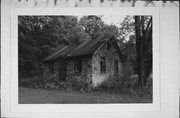Property Record
117 RIVER RD
Architecture and History Inventory
| Historic Name: | ROBERT LEO MILLER HOUSE |
|---|---|
| Other Name: | |
| Contributing: | |
| Reference Number: | 24479 |
| Location (Address): | 117 RIVER RD |
|---|---|
| County: | Shawano |
| City: | |
| Township/Village: | Bartelme |
| Unincorporated Community: | STOCKBRIDGE-MUNSEE RESERVATION |
| Town: | |
| Range: | |
| Direction: | |
| Section: | |
| Quarter Section: | |
| Quarter/Quarter Section: |
| Year Built: | 1937 |
|---|---|
| Additions: | |
| Survey Date: | 1989 |
| Historic Use: | house |
| Architectural Style: | Rustic Style |
| Structural System: | |
| Wall Material: | Fieldstone |
| Architect: | |
| Other Buildings On Site: | |
| Demolished?: | No |
| Demolished Date: |
| National/State Register Listing Name: | Not listed |
|---|---|
| National Register Listing Date: | |
| State Register Listing Date: |
| Additional Information: | A 'site file' exists for this property. It contains additional information such as correspondence, newspaper clippings, or historical information. It is a public record and may be viewed in person at the Wisconsin Historical Society, State Historic Preservation Office. These stone houses built by the Works Progress Administration represent a historical turning point for the Stockbridge-Munsee community. Native to the Hudson, Housatonic, and upper Delaware Valleys, the Mohican tribes later known as the Stockbridge-Munsee sided with the colonists during the Revolutionary War. Their loyalty failed to preserve their New York and New England homelands, so after 1802 they banded with other displaced northeastern tribes to find refuge among New York’s Oneida. In 1818, two tribal members sought out western lands for settlement, and the Stockbridge-Munsee band arrived in Wisconsin between 1822 and 1829. In 1856, they settled a reservation in Shawano County, but by the 1870s they had lost much of their land to logging companies. The federal government dissolved the communal reservation in 1910 and allotted plots of cutover land to individual members of the Stockbridge-Munsee tribe. Many could not pay their property taxes and lost their allotments within two decades. The 1930s New Deal brought a revolution in federal Indian policy. Under the aegis of Indian Commissioner John Collier and the Indian Reorganization Act of 1934, the federal government returned more than one thousand acres to the Stockbridge-Munsees and provided low-interest loans to construct houses. The WPA built sixteen stone houses on the Stockbridge-Munsee Reservation under this program. These vernacular examples of Craftsman-style architecture were based on stock plans. Each is a one-and-one-half story house with granite rubble walls laid in irregular courses. The local stone harmonizes with the immediate environment. Although the houses appear similar, each is distinguished by details. For example, the Edwin and Margaret Martin House (N9448 Mo-He-Con-Nuck Rd.) features a large shed dormer across the front and an arched brick head over the door. Both the Roy and Louanna Miller House (N9299 Mo-He-Con-Nuck Rd.) and the Miles Welch House (W13302 River Rd.) have gabled hoods over the entry stoop, and the Dudley and Lyla Davids House (N8552 Mo-He-Con-Nuck Rd.) uses large gabled wall-dormers to create a roomier second story. Over the years, the owners have altered some windows and added rooms. |
|---|---|
| Bibliographic References: | Buildings of Wisconsin manuscript. |
| Wisconsin Architecture and History Inventory, State Historic Preservation Office, Wisconsin Historical Society, Madison, Wisconsin |

